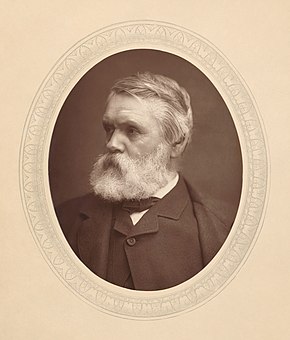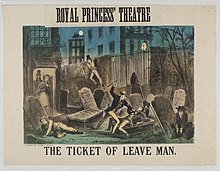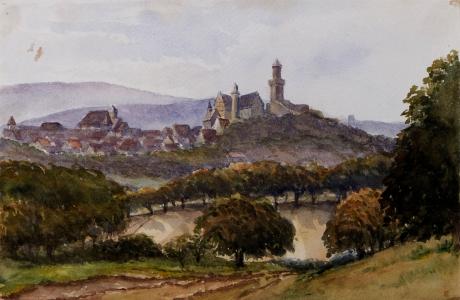inscribed and dated "Kronberg im Taunus near Hamburg Sep 1861" and signed with initials "TT"
Tom and Laura Taylor and thence by descent
Kronberg im Taunus is a town in the Hochtaunuskreis district, Hesse, Germany and part of the Frankfurt Rhein-Main urban area. Before 1866, it was in the Duchy of Nassau; in that year the whole Duchy was absorbed into Prussia. Kronberg lies at the foot of the Taunus, flanked in the north and southwest by forests. A mineral water spring also rises in the town.

Kronberg borders in the north and east on the town of Oberursel, in the southeast on the town of Steinbach, in the south on the towns of Eschborn and Schwalbach (both in Main-Taunus-Kreis), and in the west on the town of Königstein.
Kronberg consists of the three centres of Kronberg (8,108 inhabitants), Oberhöchstadt (6,363 inhabitants) and Schönberg (3,761 inhabitants).




When Kronberg Castle was built (about 1220) it was shared by the Knights of Askenburne (Eschborn), who owned a towered castle there. The Kronenstamm (stamm = stem) moved to Kronberg, giving themselves that name at the time, while the Flügelstamm ("wing stem") followed them there only 30 years later.
Town rights were granted the small settlement on 25 April 1330 by Louis IV, Holy Roman Emperor. As of 1367, the town also had market rights as well as Blutgerichtsbarkeit (meaning that there was an Imperial court authorized to mete out bodily punishment, including death), granted by Charles IV, Holy Roman Emperor. Together with those from Hattstein Castle and Reifenberg Castle, the Knights of Kronberg from Frankfurt declared the so-called "Kronberg Feud" in 1389. When on 13 May a great force from Frankfurt swept to Kronberg Castle, Hanau (Ulrich von Hanau) and the Electorate of the Palatinate (150 of Ruprecht von der Pfalz's cuirassiers) troops rushed to help those being beset, driving the Frankfurt forces off on 14 May in the Battle of Eschborn and taking 620 prisoners, among them the mayor, a few noble council members and all the town's bakers, butchers, locksmiths and shoemakers.
The story is told in Kronberg that during the battle one of the knights of Kronberg was unhorsed, and because he lacked a replacement mount, he returned to battle on a donkey. Legend has it that it was the unearthly noise the donkey made in battle that made the Frankfurt army run, and this gave birth to the third "Stem", the Ohrenstam (Earstem) - with a pair of donkeys ears on its coat of arms.
Only the huge ransom of 73,000 golden guilders – negotiated on 22 August, the pain of which Frankfurt would feel for 120 years – ended the fight with Frankfurt and laid the groundwork for the Frankfurter Landwehr fortifications. Peace was, however, quickly concluded (1391) and alliance sought with Kronberg. In 1394, the council appointed Hartmuth von Cronberg to a two-year term as Bailiff of Bonames, and in 1395, Johann von Cronberg concluded a detailed treaty of federation with Frankfurt, which the Kronbergers bound the Frankfurters and their masses to protect. Finally, in 1398, the "Schießgesellen zu Cronenberg" ("Journeymen shooters of Kronberg") invited the "Schießgesellen zue Franckenfurd unsern guten frunden" ("Journeymen shooters of Frankfurt, our good friends") to a "Schießen umb eyn Cleynod" ("shoot for a treasure"). The letter bearing this message is said to be Germany's oldest surviving invitation to a shooting event (this refers to early weapons, since firearms were as yet unknown).
Since Hartmut XII of Kronberg, who is said to be the town's Reformer, had earlier stood by his cousin Franz von Sickingen in his attack on Trier and Worms, Archbishop Richard von Greiffenklau zu Vollrads of Trier, Ludwig V of the Electorate of the Palatinate and Philip I, Landgrave of Hesse attacked the town and the castle at Kronberg in 1522 and forced an unconditional surrender. Hartmut fled, and Philip introduced the Reformation throughout Hesse. However, since Kronberg was an Imperial fief, Philip had to give the castle and town back to Hartmut in 1541 under the issuing of property rights for the Lutheran Church. These rights were affirmed by Hesse-Darmstadt in the 17th and 18th centuries, ensuring that Mainz's later attempts at a Counterreformation (1626–1649) and the Simultanisierung (1737–1768) would never enjoy success.
In 1704, the last member of the ruling family, Herr Johann Niclas von und zu Cronberg, died childless at Hohlenfels Castle in Mudershausen. Kronberg, along with the communities of Schönberg, Niederhöchstadt and Eschborn therefore passed to the Electorate of Mainz.
It was under Mainz's rule that the nowadays so-called "Dispute Church" ("Streitkirche") was built, having been planned as a Catholic church in 1758 to be built right next to the Evangelical church. This led to great protests by the town's Evangelical majority, whose plight reached the Eternal Imperial Diet (Immerwährender Reichstag) in Regensburg, where the Evangelicals were granted their wish, and although the building was built anyway, it was never consecrated as a church. Since 1768, the building has served secular purposes (as a pharmacy, guesthouse, and today as the Kronberg Painters' Colony's museum).

In the Treaty of Lunéville in 1801, the Electorate of Mainz lost its worldly territory, including the Imperial fief of Kronberg, which was confiscated by the Prince of Nassau-Usingen in 1802, and formally awarded to him in 1803. In the Austro-Prussian War of 1866, the Duke of Nassau sided with Austria, thereby losing his land to Prussia.
Wealthy industrialists, traders and bankers discovered the little Taunus town's idyllic and climatically advantageous setting right near Frankfurt in the middle of the 19th century and built villas and summer homes in Kronberg and Schönberg. Even artists, among them Anton Burger and Jakob Fürchtegott Dielmann, came to Kronberg and founded the Kronberg Painters' Colony, which lasted into the 20th century. Some of the Kronberg painters' works are on display in the museum at the "Dispute Church". The small town, for so long shaped by smallholders and craftsmen reached in its "Prussian epoch" its first upswing with the building of the Kronberg-Rödelheim railway (1874) and the luxurious Schloss Friedrichshof (1889–94) often called "Kronberg", the residence of Princess Victoria, eldest daughter of Queen Victoria and German Dowager Empress.
After the Second World War, Kronberg belonged to Gross-Hessen ("Greater Hesse" – a provisional name for the state that was later dropped), and remains in Hesse today.
In 1946, the Papal Mission for Displaced Persons in Germany was moved to Kronberg by Pope Pius XII. The apostolic visitor and leader of the institution was the Bishop of Fargo, North Dakota, USA Aloisius Muench, who was of German heritage. His spiritual guidance mandate included caring for those who had fled or been driven out of Eastern Europe. Until the summer of 1949, he organized from Kronberg the transport of about 950 goods wagons full of Papal aid supplies to Germany. He was also supported by the US Government; before taking his position in Kronberg, he received from US Secretary of War Robert P. Patterson the document of appointment as liaison commissioner for religious affairs to the US military government in Germany. Through his contacts in the USA Muench arranged a formidable flow of donations into destruction-stricken Germany. After the Federal Republic of Germany was founded, the Kronberg Apostolic Mission was dissolved in 1951. Muench afterwards became the first Apostolic Nuncio in the Federal Republic of Germany (West Germany). In 1959, Pope John XXIII made Archbishop Muench a Cardinal.
Since 28 June 1966, Kronberg has been a state-recognized spa town.
As part of Hesse's municipal reforms, on 1 April 1972, Kronberg merged with the formerly independent communities of Oberhöchstadt and Schönberg.

Tom Taylor (19 October 1817 – 12 July 1880) was an English dramatist, critic, biographer, public servant, and editor of Punch magazine. Taylor had a brief academic career, holding the professorship of English literature and language at University College, London in the 1840s, after which he practised law and became a civil servant. At the same time he became a journalist, most prominently as a contributor to, and eventually editor of Punch.
In addition to these vocations, Taylor began a theatre career and became best known as a playwright, with up to 100 plays staged during his career. Many were adaptations of French plays, but these and his original works cover a range from farce to melodrama. Most fell into neglect after Taylor's death, but Our American Cousin (1858), which achieved great success in the 19th century, remains famous as the piece that was being performed in the presence of Abraham Lincoln when he was assassinated in 1865.
Early years
Taylor was born into a newly wealthy family at Bishopwearmouth, a suburb of Sunderland, in north-east England. He was the second son of Thomas Taylor (1769–1843) and his wife, Maria Josephina, née Arnold (1784–1858). His father had begun as a labourer on a small farm in Cumberland and had risen to become co-owner of a flourishing brewery in Durham. After attending the Grange School in Sunderland, and studying for two sessions at the University of Glasgow, Taylor became a student of Trinity College, Cambridge in 1837, was elected to a scholarship in 1838, and graduated with a BA in both classics and mathematics. He was elected a fellow of the college in 1842 and received his MA degree the following year.

Taylor left Cambridge in late 1844 and moved to London, where for the next two years he pursued three careers simultaneously. He was professor of English language and literature at University College, London, while at the same time studying to become a barrister, and beginning his life's work as a writer. Taylor was called to the bar of the Middle Temple in November 1846. He resigned his university post, and practised on the northern legal circuit until he was appointed assistant secretary of the Board of Health in 1850. On the reconstruction of the board in 1854 he was made secretary, and on its abolition in 1858 his services were transferred to a department of the Home Office, retiring on a pension in 1876.
Writer
Taylor owed his fame and most of his income not to his academic, legal or government work, but to his writing. Soon after moving to London, he obtained remunerative work as a leader writer for the Morning Chronicle and the Daily News. He was also art critic for The Times and The Graphic for many years. He edited the Autobiography of B. R. Haydon (1853), the Autobiography and Correspondence of C. R. Leslie, R.A. (1860) and Pen Sketches from a Vanished Hand, selected from papers of Mortimer Collins, and wrote Life and Times of Sir Joshua Reynolds (1865). With his first contribution to Punch, on 19 October 1844, Taylor began a thirty-six year association with the magazine, which ended only with his death. During the 1840s he wrote on average three columns a month; in the 1850s and 1860s this output doubled. His biographer Craig Howes writes that Taylor's articles were generally humorous commentary or comic verses on politics, civic news, and the manners of the day. In 1874 he succeeded Charles William Shirley Brooks as editor.
Taylor also established himself as a playwright and eventually produced about 100 plays. Between 1844 and 1846, the Lyceum Theatre staged at least seven of his plays, including extravanzas written with Albert Smith or Charles Kenney, and his first major success, the 1846 farce To Parents and Guardians. The Morning Post said of that piece, "The writing is admirable throughout – neat, natural and epigrammatic". It was as a dramatist that Taylor made the most impression – his biographer in the Dictionary of National Biography (DNB) wrote that in writing plays Taylor found his true vocation. In thirty-five years he wrote more than seventy plays for the principal London theatres.

A substantial portion of Taylor's prolific output consisted of adaptations from the French or collaborations with other playwrights, notably Charles Reade. Some of his plots were adapted from the novels of Charles Dickens or others. Many of Taylor's plays were extremely popular, such as Masks and Faces, an extravaganza written in collaboration with Reade, produced at the Haymarket Theatre in November 1852. It was followed by the almost equally successful To Oblige Benson (Olympic Theatre, 1854), an adaptation from a French vaudeville. Others mentioned by the DNB are Plot and Passion (1853), Still Waters Run Deep (1855) and The Ticket-of-Leave Man (based on Le Retour de Melun by Édouard Brisebarre and Eugène Nus), a melodrama produced at the Olympic in 1863.Taylor also wrote a series of historical dramas (many in blank verse), including The Fool’s Revenge (1869), an adaption of Victor Hugo's Le roi s'amuse (also adapted by Verdi as Rigoletto), 'Twixt Axe and Crown (1870), Jeanne d'arc (1871), Lady Clancarty (1874) and Anne Boleyn (1875). The last of these, produced at the Haymarket in 1875, was Taylor's penultimate piece and only complete failure. In 1871 Taylor supplied the words to Arthur Sullivan's dramatic cantata, On Shore and Sea.
Like his colleague W. S. Gilbert, Taylor believed that plays should be readable as well as actable; he followed Gilbert in having copies of his plays printed for public sale. Both authors did so at some risk, because it made matters easy for American pirates of their works in the days before international copyright protection. Taylor wrote, "I have no wish to screen myself from literary criticism behind the plea that my plays were meant to be acted. It seems to me that every drama submitted to the judgment of audiences should be prepared to encounter that of readers".

Many of Taylor's plays were extremely popular, and several survived into the 20th century, although most are largely forgotten today. His Our American Cousin (1858) is now remembered chiefly as the play Abraham Lincoln was attending when he was assassinated, but it was revived many times during the 19th century with great success. It became celebrated as a vehicle for the popular comic actor Edward Sothern, and after his death, his sons, Lytton and E. H. Sothern, took over the part in revivals.
Howes records that Taylor was described as "of middle height, bearded [with] a pugilistic jaw and eyes which glittered like steel". Known for his remarkable energy, he was a keen swimmer and rower, who rose daily at five or six and wrote for three hours before taking an hour's brisk walk from his house in Wandsworth to his Whitehall office.
Some, like Ellen Terry, praised Taylor's kindness and generosity; others, including F. C. Burnand, found him obstinate and unforgiving. Terry wrote of Taylor in her memoirs:
Most people know that Tom Taylor was one of the leading playwrights of the 'sixties as well as the dramatic critic of The Times, editor of Punch, and a distinguished Civil Servant, but to us he was more than this. He was an institution! I simply cannot remember when I did not know him. It is the Tom Taylors of the world who give children on the stage their splendid education. We never had any education in the strict sense of the word yet through the Taylors and others, we were educated.
Terry's frequent stage partner, Henry Irving said that Taylor was an exception to the general rule that it was helpful, even though not essential, for a dramatist to be an actor to understand the techniques of stagecraft: "There is no dramatic author who more thoroughly understands his business".
In 1855 Taylor married the composer, musician and artist Laura Wilson Barker (1819–1905). She contributed music to at least one of his plays, an overture and entr'acte to Joan of Arc (1871), and harmonisations to his translation Ballads and Songs of Brittany (1865). There were two children: the artist John Wycliffe Taylor (1859–1925) and Laura Lucy Arnold Taylor (1863–1940). Taylor and his family lived at 84 Lavender Sweep, Battersea, where they held Sunday musical soirees. Celebrities who attended included Lewis Carroll, Charles Dickens, Henry Irving, Charles Reade, Alfred Tennyson, Ellen Terry and William Makepeace Thackeray.
Taylor died suddenly at his home in 1880 at the age of 62 and is buried in Brompton Cemetery. After his death, his widow retired to Coleshill, Buckinghamshire, where she died on 22 May 1905.

